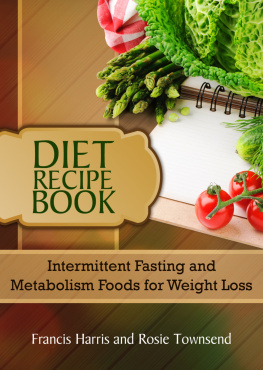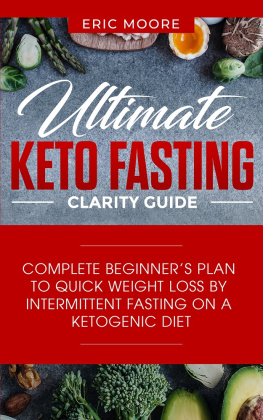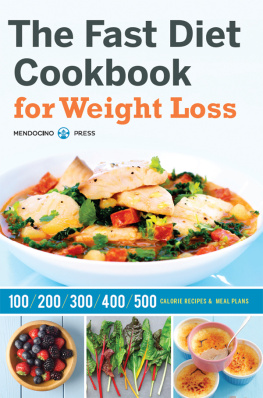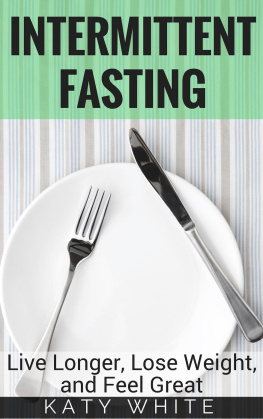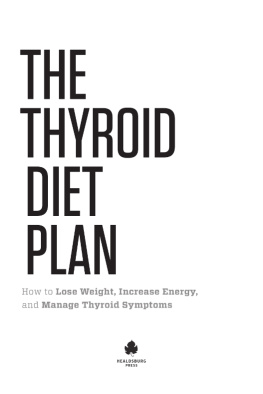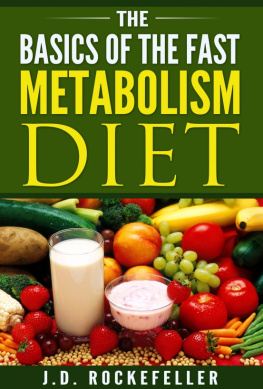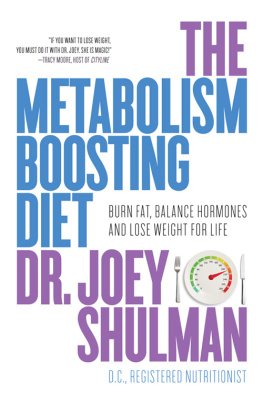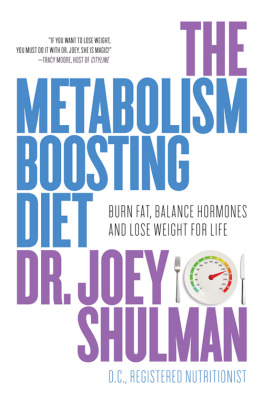Table of Contents
Diet Recipe Book
Intermittent Fasting and Metabolism Foods for Weight Loss
Francis Harris and Rosie Townsend
Copyright 2013 Francis Harris and Rosie Townsend
All rights reserved.
Introduction
If weight loss is your goal then you have a perfect start by choosing to go on the Intermittent Fasting Diet and the Metabolism Diet plans. Both diet plans are represented in this book.
Why Lose Weight?
Even if you feel good with the excessive weight, it probably won't last for long. Excessive weight gain can take a toll on the body. Here are the possible unpleasant side effects to being overweight: low energy level, high blood pressure, high cholesterol, high blood sugar, pain in bones and joints, muscle fatigue, and bad circulation. These conditions can lead to health concerns that are more serious such as cardiovascular disease, diabetes, and greater weight gain.
By losing weight, you lower your risks of the above health concerns considerably if not altogether. Going on a diet to lose weight is one of the safest and most effective methods of becoming healthier. But you must look at the dieting as a lifestyle change and not as a temporary fix. If you have gained weight then you obviously do not eat, as you should. If you go on a diet long enough to lose the weight and then go back to your old eating habits you will gain the weight back. You can do several things to make this a permanent lifestyle change. One is to break the junk food habit permanently. The other is to add exercise to your weekly routines.
Breaking the Junk Food Habit
A food eating habit is just like any other habit, and when it's junk food it's an intense bad habit. It is as real as a smoking or drinking habit. It takes the body about three weeks to wean completely from such bad habits. Sometimes the body needs help going through the weaning process. While you can stop eating (or smoking or drinking) you may have some bad withdrawal symptoms.
Junk food contains little to no nutrients. Eating it only adds fat to the body and makes the body more susceptible to the illnesses and physical conditions listed earlier. If you break the junk food habit, you will be more likely to stick on the diet. By breaking the junk food habit with a weaning process, you can do this painlessly. Stopping junk food without weaning may lead to unpleasant side effects such as headaches, moodiness, and intense food cravings, cravings for more junk food.
Start the weaning process by eating junk food just three times a day for five days. Do not eat it more than three. On the sixth day, eat it just twice a day for five days. On the eleventh day, eat it just once a day for five days. After this skip a day between eating junk food just once and do this for a week. After going through this process of elimination, you should be able to let go of the junk food fairly easily. If you still have issues with food cravings, skip two days for a week, then skip three days until you are eating junk food just once a week. Most people report they no longer crave it if they go through this process of elimination.
Physical Activity and Dieting
The body needs to be in motion in order to be healthy. The reason so many people struggle with issues of being overweight is due in part to a sedentary lifestyle. While we may be living very busy lifestyles we are often not physically active more so than we go from one chair to another. Technology is wonderful, but with its ever-increasing advances, we find more and more of us are stuck sitting in front of computers. This "butt in chair" leads us to sedentary lifestyles that add to our overweight issues.
In truth, it takes very little physical activity to help us be fit and healthy. It is not as if we must commit to several hour workouts every day at the gym to be fit. People mistakenly think that is what they must do and instead of doing something, they feel overwhelmed before they even start and do nothing. Follow some simple guidelines to be physically active and watch how it helps to lose the weight, have more energy, and feel better all the way around.
Physical activity just means you break a sweat by doing something physical for about a half an hour at a time. Ideally, you will want to exercise every other day for best results. Here are some good exercise suggestions: walking, running, jogging, swimming, bicycling, aerobics, weight lifting, gym circuit workout, dancing, playing sports such as baseball, softball, tennis, or soccer, and skating. Spend about five to ten minutes before and after the "workout" doing a warm up and cool down of stretches. Spend about half an hour working up to a sweat to make the exercise work. Do this at least every other day. This will help to reach your goals with weight loss.
Exercise helps to give you more energy, even though when you first start out you may not feel like doing it. It is something that once you get started it has a snowball effect where the energy builds. People often talk about feeling the runner's high after a good strenuous run. This happens because the body releases endorphins, a substance that helps to bring about a natural high. It helps to cure depression. Regular exercise helps to boost the metabolism, so the more you do it the more you will want to do it.
Disclaimer
Any new diet or exercise routine needs to be discussed with your health care provider first. All the advice in this book is for informational purposes only. This book is not meant to diagnose or treat any health condition. The recipes are nutritious and follow the intermittent fasting and metabolism boosting diet plans. As with any diet you will get out of it what you put into it. If you wish to succeed with the diet, stick with it and make a plan to change your lifestyle to eat healthier.
Section 1: Metabolism Diet
The metabolism diet is a diet in which addresses issues some people have who suffer from certain ailments that prevents them from dieting with other diet plans successfully. The bottom line is that unless you have enough energy to digest food properly, dieting will not help. On top of a sluggish digestive system, people who suffer from these issues also suffer from fatigue, lethargy, anxiety, weight gain, and the worse yet, craving bad carbohydrates. It also causes irritable and a low sex drive.
The metabolism diet helps a person to overcome the above issues, which may have prevented them from losing weight in the first place. By eating certain foods the body is able to build up energy, burn calories and fat and lose the weight.
Metabolism Diet Allowable Foods
The metabolism diet is very similar to the "low carb" diet, only not as extreme as the "low carb" diet. However, carbohydrates are very restricted. There are a few allowable carbs, but they fall in the category of being a "low carb" food, such as "low carb" breads and crackers. It is also a sugar free diet, so you are allowed "sugar free" foods; foods sweetened either naturally or with a sugar substitute. You are allowed all lean meats, and all "non starchy" vegetables. When going through the first who steps or phases of the diet you are supposed to limit the carbohydrate intake to just 5 grams every five hours. By step two, you can increase that to 20 grams every five hours. Then during maintenance, you are allowed 35 percent carbohydrate calories every five hours. It still requires you to think in terms of "low carb."
Metabolism Diet Avoided Foods List
Just like with the low carb diet, you are not allowed anything with sugar, which includes most "convenient" processed foods that contains enriched flours. In addition to the obvious sugary junk foods, these foods are on the avoid list: beans, bread, carrots, milk, parsnips, peas, pumpkin, rice, and yogurt. There are a few recipes below that call for minute amounts of milk, or a teaspoon or tablespoon of sugar, but it is dispersed through the dish so that there is not enough per serving to matter.

